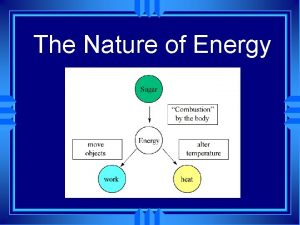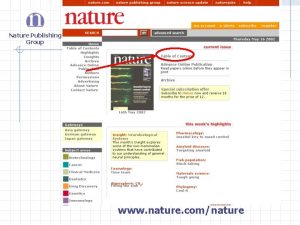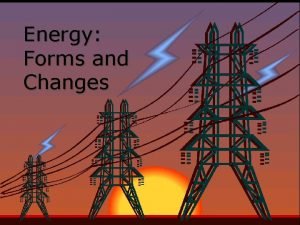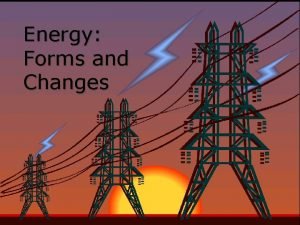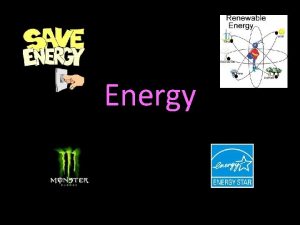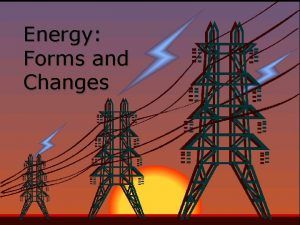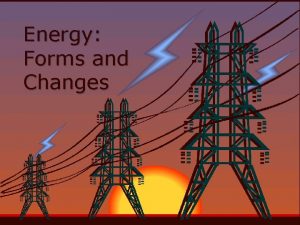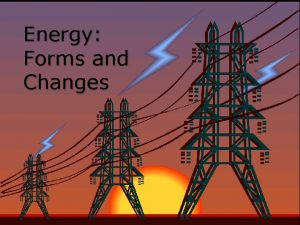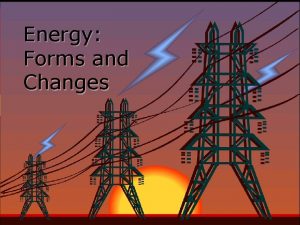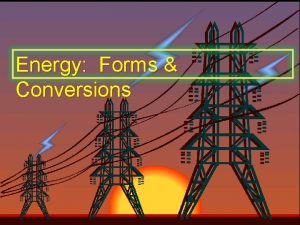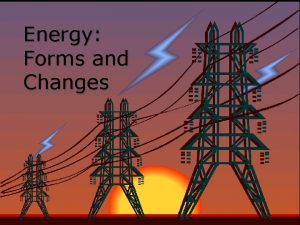The Nature of Energy The Nature of Energy

























- Slides: 25

The Nature of Energy

The Nature of Energy l The ability to cause change. l Scalar quantity. l Does NOT depend on direction. l Unit: kg*m 2/s 2 l = N*m l = Joule (J) l All energy can be broadly classified as potential or kinetic. l Potential energy – energy in storage. l Kinetic energy – energy in motion.

Forms of Energy l Energy can change from one form to another. l Remember “I SCREAM” I = Internal l S = Sound l C = Chemical l R = Radiant l E = Electrical l A = Atomic l M = Mechanical l

Forms of Energy l Internal Energy l energy assoc. with particles in a substance. l temperature and phase are assoc. w/ internal energy. l Sound Energy l released when an object vibrates. l needs a medium in which to travel.

Forms of Energy l Chemical Energy stored in chemical bonds. l Batteries, gasoline, and food all store chemical potential energy. l Radiant Energy l Energy carried by light. l Electrical l Energy assoc. w/ the movement of electrons through a substance.

Forms of Energy l Atomic Energy l Energy stored in the nucleus of an atom (nuclear energy). l Mechanical l Kinetic Energy = energy assoc. with a moving object. l Potential = energy assoc. with an object b/c of its position or deformation.

Kinetic Energy (K) l Energy l. K of a moving object. = ½ mv 2

Kinetic Energy

Kinetic Energy

Kinetic Energy l What is the kinetic energy of a 1500. -kg vehicle moving at 20. 0 m/s? l. K = ½ mv 2 l K = ½ (1500. kg)(20. 0 m/s)2 l K = ½ (1500. kg)(400. m 2/s 2) l K = 3. 00 x 105 J

Kinetic Energy l. A . 30 -06 bullet has a mass of 11. 2 grams and a kinetic energy of 3840 J. What is the speed of the bullet? l First convert grams l 11. 2 g = 0. 0112 kg l. K to kilograms: = ½ mv 2 l 3840 J = ½ (0. 0112 kg)v 2 l 686 000 m 2/s 2 = v 2 l v = 828 m/s

Gravitational Potential Energy l Ug – Energy stored by an object because of its position in a gravitational field. l Ug = mgh lm = mass (kg) l g = gravity (m/s 2) l h = height (m) l Must always be measured relative to some point.

Gravitational Potential Energy l As an object falls, Ug turns to K. l Ug + K = Mechanical Energy l In a world w/o friction, Mech. Energy is constant. l. K l In + Ug = constant for all falling bodies the real world, friction robs moving objects of energy l Mech. Energy of a free-falling body in Earth’s atmosphere constantly diminishes.

Mechanical Energy Ug, o K = Ug, o Ideal World K=0 Real World Ug, o K=0 K < UG, o

Mechanical Energy l. A 2. 00 -kg stone is dropped from a height of 50. 0 meters. What is its velocity when it reaches the ground? (Ignore air resistance) l In the absence of drag, its K upon reaching the ground = its starting Ug. l Ug = mgh = (2. 00 kg)(9. 81 m/s 2)(50. 0 m) l Ug = 981 J l K = 981 J

Mechanical Energy l. A 2. 00 -kg stone is dropped from a height of 50. 0 meters. What is its velocity when it reaches the ground? (Ignore air resistance) l. K = 981 J l 981 J = ½ (2. 00 kg)v 2 l 981 J = (1. 00 kg)v 2 l 981 m 2/s 2 = v 2 l v = 31. 3 m/s

Mechanical Energy l The Titan roller coaster at Six Flags Over Texas features a drop of 255 feet (77. 7 meters) and has a top speed of 85 mph (38. 0 m/s).

Mechanical Energy l If the mass of a roller coaster train is 5000. kg, what is the GPE of the train at the top of the first hill (relative to the bottom of the hill)? GPE = mgh = (5000. kg)(9. 81 m/s 2)(77. 7 m) l GPE = 3. 81 x 107 J l Ug = 38. 1 million Joules

Mechanical Energy l The 5000. -kg train is moving at 38. 0 m/s at the bottom of the first hill. What is the car’s KE? KE = ½ mv 2 l KE = ½ (5000. kg)(38. 0 m/s)2 l KE = 3. 61 x 107 J l Ug = 38. 1 million Joules K = 36. 1 million Joules

Mechanical Energy l How much of the car’s Mech. Energy was converted to other forms in the first drop? l l 3. 81 x 107 J – 3. 61 x 107 J = 2. 0 x 106 J What kinds of energy might the mechanical energy have been converted to? Ug = 38. 1 million Joules K = 36. 1 million Joules

Mechanical Energy l Imagine a 50. 0 -kg crate perched on shelf 2. 0 meters above the ground. l Now imagine the same crate on the same shelf, except now it’s on the Moon. l Does the crate have more, the same, or less Ug on the Moon than it has on Earth? has less because g is smaller on the Moon than it is on Earth. l It

Elastic Potential Energy l Ue = energy stored by an object when it is deformed. l Most l Ue common example: springs = ½ kx 2 lk = spring constant (N/m) l x = stretch (m)

For You Calculus People l Recall that Fspring = kx. l If f(x) = ½ kx 2, then f’(x) = kx l In other words, the force needed to stretch a spring to a distance x is the first derivative of the potential energy stored in the spring when it is stretched to x. l Also, the potential energy is the integral of a force-vs-stretch graph.

Elastic Potential Energy F x k = Ue = ½ kx 2

Elastic Potential Energy l How much force is required to stretch a 50. 0 -N/m spring 25. 0 cm? How much potential energy is stored in the stretched spring? l Fs = kx l Fs = (50. 0 N/m)(0. 250 m) = 12. 5 N l Ue = ½ kx 2 l Ue = ½ (50. 0 N/m)(0. 250 m)2 = 1. 56 J
 Energy energy transfer and general energy analysis
Energy energy transfer and general energy analysis Energy energy transfer and general energy analysis
Energy energy transfer and general energy analysis Nature and nature's law lay hid in night meaning
Nature and nature's law lay hid in night meaning Nature nature controversy
Nature nature controversy Hình ảnh bộ gõ cơ thể búng tay
Hình ảnh bộ gõ cơ thể búng tay Lp html
Lp html Bổ thể
Bổ thể Tỉ lệ cơ thể trẻ em
Tỉ lệ cơ thể trẻ em Chó sói
Chó sói Tư thế worm breton là gì
Tư thế worm breton là gì Chúa yêu trần thế alleluia
Chúa yêu trần thế alleluia Môn thể thao bắt đầu bằng chữ đua
Môn thể thao bắt đầu bằng chữ đua Thế nào là hệ số cao nhất
Thế nào là hệ số cao nhất Các châu lục và đại dương trên thế giới
Các châu lục và đại dương trên thế giới Công thức tính độ biến thiên đông lượng
Công thức tính độ biến thiên đông lượng Trời xanh đây là của chúng ta thể thơ
Trời xanh đây là của chúng ta thể thơ Mật thư tọa độ 5x5
Mật thư tọa độ 5x5 Làm thế nào để 102-1=99
Làm thế nào để 102-1=99 độ dài liên kết
độ dài liên kết Các châu lục và đại dương trên thế giới
Các châu lục và đại dương trên thế giới Thể thơ truyền thống
Thể thơ truyền thống Quá trình desamine hóa có thể tạo ra
Quá trình desamine hóa có thể tạo ra Một số thể thơ truyền thống
Một số thể thơ truyền thống Cái miệng xinh xinh thế chỉ nói điều hay thôi
Cái miệng xinh xinh thế chỉ nói điều hay thôi Vẽ hình chiếu vuông góc của vật thể sau
Vẽ hình chiếu vuông góc của vật thể sau Thế nào là sự mỏi cơ
Thế nào là sự mỏi cơ


























